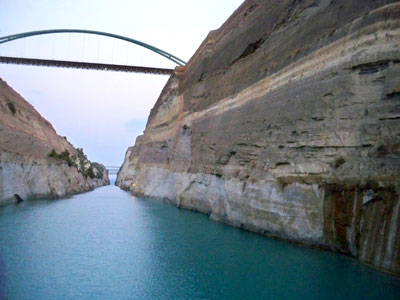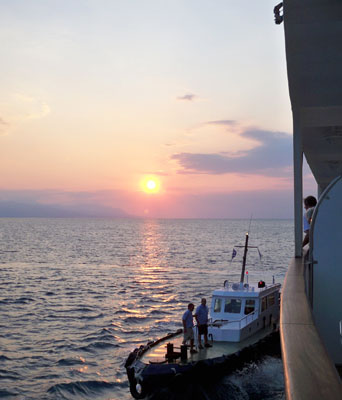The Corinth Canal
This item appears on page 12 of the February 2014 issue.
The dinner bell rang early for the evening meal aboard the small ship Athena, owned and operated by Grand Circle Cruise Lines (Boston, MA; 800/221-2610). The captain requested that the gourmet repast be served in time to give all 48 passengers the opportunity to go to the top deck by sundown to witness the ship’s passage through 2,300 years of history.
“Grand Circle’s “Hidden Gems of the Dalmatian Coast” cruise-tour (with air from Houston to Zagreb and back from Athens, $6,763), July 3-17, 2013, included three days to explore Zagreb, Croatia, before the group would board the spacious, luxurious, 24-cabin Athena in Split for an 11-night cruise.”
Skirting the Dalmatian Coast, the ship made port stops at Croatian hot spots of the yachting rich — the islands of Hvar and Korcˇula — then the fabled metropolis of Dubrovnik. We toured Kotor in Montenegro, visited the Greek and Roman ruins of Butrint in Albania and cruised to the Greek island of Corfu. At Delphi, we climbed to explore the Oracle of Apollo, soaking up centuries of antiquity under the kiss of the Adriatic sun.
As the ship voyaged toward Athens, our guide, Luci, informed us that we were about to encounter one of the highlights of the whole trip, the Corinth Canal, which has played a significant role in Grecian history since the seventh century BC.
We crowded onto the forward deck above the ship’s navigational bridge, eager for the show. The sun slinked slowly into the Ionian Sea behind us, creating a mango-colored glow on the sliver of a canal cutting through the isthmus ahead of us.
In ancient times the isthmus linked the Peloponnese, the southern peninsula of Greece, with the mainland to the north, the two land masses mostly being separated by the Gulf of Corinth, running east to west between them.
The construction of the canal completely separated the two land masses, making the Peloponnese an island and eliminating the need to make the 185-nautical-mile route around it. Simply put, the Corinth Canal provides the navigational shortcut link between the Ionian Sea and the Aegean Sea.
A tugboat pulled alongside the Athena, and a local pilot boarded to assist the captain and crew in navigating through the 70-foot-wide, 4-mile passage. Some vessels require a tugboat to pull them through. Due to its limited width, the canal is impassable for larger modern ships. Now only smaller tourist boats, yachts and freighters use it, about 11,000 a year.
A red light at the canal’s entrance indicated that the Athena had to wait until a yacht sailing through from east to west in the 26-foot-deep, single-channel conduit had exited.
We marveled as the road-level bridge at the mouth of the canal rose from beneath the water to allow waiting cars and traffic to pass over the gulf. Then the sinking bridge submerged again to allow the Athena clear passage. The light turned green, and our exciting history lesson and real-time experience began as the ship moved through this incredibly narrow slit carved out between two, near-vertical limestone walls rising up to nearly 300 feet above the water.
Beginning with the tyrant Periander in 602 BC, ancient rulers dreamed of slicing through the thin ribbon of land. Due to the project’s cost, Periander built an overland portage road, called the Diolkos, across the isthmus instead. Ships were unloaded and cargo was transported by hand, the vessels towed on wheeled carts to the other side, then lowered back into the sea and reloaded. Vestiges of this ancient system still exist.
Three Roman rulers considered the idea of cutting through the isthmus, but the philosopher Apollonius of Tyrana prophesied that Poseidon, God of the Sea, would cause grave personal tragedy to anyone proposing to dig a canal. In fact, neither Julius Caesar, Nero nor Caligula were successful in their attempts to build a canal. In 1687 the Venetians gave it thought but declined to proceed.
The Athena entered the narrowest section of the canal, and the closeness of the ship’s sides to the vertical walls gave the illusion of metal brushing against limestone. The crystal-clear water in the channel showed aqua hues tinged with pink tones from the sunset residue.
We waved to onlookers overhead standing on the motor bridge that crossed the canal hundreds of feet above us and heard the whistle from the passenger train that traversed the railway bridge span. Luci continued describing the canal’s traumatic history.
After Greece gained independence from the Ottoman Empire in 1830, its government revisited the idea of a Corinth Canal, but the young nation had no funds for construction. Once the Suez Canal was completed in 1869, however, the Grecian parliament passed a law mandating construction of the canal in 1870.
The project remained fraught with problems, and the French company assigned to build it went bankrupt after their Panama Canal debacle. Following two more bankruptcies, a Greek company took over in 1890 and the canal became a reality, formally opening to sea traffic on July 25, 1893.
Even then, Poseidon’s relentless attack on the Corinth Canal continued. High winds raced through the narrow slit, strong undertow currents created danger for ships in the passage, and landslides tumbled from the limestone walls in this active seismic zone, requiring retaining walls to be built.
During WWII, Nazis used explosives to set off rock slides, destroyed the bridge spans and dumped materials, tracks and locomotives into the canal to block passage. Finally, in 1947, the US Army Corps of Engineers cleared the canal and reopened it for transit on July 7, 1948.
The Athena neared the end of the 4-mile open-air tunnel, where the Aegean Sea waited to escort us to Piraeus, Greece, our port for exploring Athens. The red light glowed until the ship had completely exited the channel.
Having experienced passage through the Corinth Canal, one of the most troubled maritime conveyances in history, I said a private ‘Thank you’ to Poseidon for allowing us the thrill of a safe and exciting transit.
CAROL L. BOWMAN
Chapala, Jalisco, Mexico


